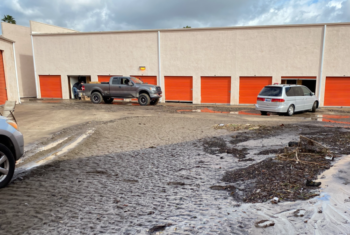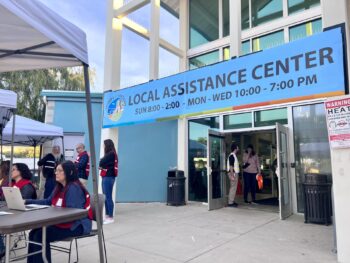It used to be if you committed a felony in California, you’d expect prison. Once you got out, a state parole agent kept an eye on you.
But last October, realignment changed everything. Thousands of felons—so far mostly drug users or drug dealers, burglars, and thieves—are now supervised by County Probation, not State Parole. And people who commit drug, theft, or other lower-level felonies serve their sentences in County Jail.
When they get out, some of them will be on probation.
Dealing with thousands of additional felons released from jail or prison each year—trying to help them live crime free and holding them accountable if they don’t—is a critical challenge that consumes a lot of attention from San Diego County Probation and local law enforcement these days.
One promising approach is a two-year-old collaboration between the Sheriff’s Department and the Probation Department in North County that sees deputies visiting probationers at home to prevent recently released felons from committing new crimes.
“Strong partnerships and combining our powers and resources are going to be essential in successfully managing the AB109 (realignment) population in the community,” said Chief Probation Officer Mack Jenkins. “By working together and focusing on known offenders, the Probation Department and the Sheriff’s Department protect public safety and increase the chances that offenders will turn their lives around.”
Why Track Known Offenders?
The partnership is called “Tracking Known Offenders.” Every month, North County probation officers give patrol deputies in Encinitas, Vista, San Marcos, Fallbrook, and Valley Center lists of probationers in those areas who could use some extra supervision.
Patrol deputies visit these probationers at home shortly after they get out of jail and drop by now and again to establish a relationship and make sure they’re staying straight. The deputies enter the results of their visits into the Probation Department’s case management system, which helps probation officers track the progress of probationers.
“In making contacts and doing compliance checks with probationers, it gives them more of an opportunity to not reoffend and actually live a productive, crime-free life,” said San Diego County Sheriff’s Lt. Glenn Giannantonio. “Now they realize, ‘A deputy is going to knock at my door.’ It will hopefully dissuade them from reoffending. The deputy can help them find resources, too; there’s a little more help and connection to the community.”
Jenkins agrees the deputies’ work supports the Probation Department’s aims.
“The purpose of supervising offenders in the community is to hold them accountable to the terms of supervision, but also to engage them in services to help them make a positive changes in their lives,” Jenkins said. “I laud the vision and cooperative spirit of Sheriff Gore and his department for being able to bolster the efforts of the Probation Department to help achieve that goal.
Started in Encinitas in spring 2010, the program has generally targeted probationers whose risk to reoffend is classified as “medium,” based on the Probation Department’s assessment tool.
Evidence shows that probationers with a “high” risk of re-offense need the most supervision. To protect public safety, the Probation Department commits the highest ratio of officers and other resources to the high risk offenders and conducts regular home visits and compliance checks on these probationers.
But evidence is mixed on medium risk offenders. Checking in at the probation office every couple of months may be as effective as home visits for some of this population. That’s how most medium risk offenders are supervised.
Still, evidence shows some medium risk offenders do better with more supervision. Enter the Sheriff’s Department and Tracking Known Offenders.
The probationers identified for the program may benefit from interventions and services that address the roots of their criminal behavior. Regular positive and motivating conversations with deputies may also help reduce their risk of re-offense, according to research.
Likewise, when a deputy notes in Probation’s case management system that a probationer is doing well in the community, the offender’s probation officer can offer a sincere “Good job” or “Keep it up” when the offender comes into the office. That’s more positive reinforcement to help the offender make a change.
Knowing they are more likely to get caught for a violation also helps some medium risk offenders stay straight.
Deputies Tracking Probationers Pays Off
The patrol deputies in Tracking Known Offenders receive training from the Probation Department in evidence-based practices proven to rehabilitate and hold probationers accountable.
With access to Probation’s case system, deputies in the program immediately see what conditions a probationer has, “which is a huge benefit,” Giannantonio says.
Maybe a probationer with known gang ties is barred from wearing a particular color. If a patrol deputy knows the probationer and his conditions, the deputy can watch for signs that the probationer is slipping back into the gang lifestyle.
And if probationers commit new crimes, they are more likely to get caught under deputy supervision. Most people on probation or parole must submit to searches by law enforcement. A deputy who becomes suspicious that a probationer is, say, using drugs or receiving stolen property can conduct a search, Giannantonio said.
Deputies don’t always search a probationer’s home, because positive interactions are critical to the program’s success. But targeted searches increase public safety, because if the probationers are indeed committing new crimes, they should go back to jail, Giannantonio said.
As of mid-May, out of 126 probationers on the “Tracking Known Offenders” list in Encinitas and Vista, 20 had been rearrested for a new offense. Almost all these arrests came because the deputy found drugs, drug paraphernalia, or weapons on the property, Giannantonio said.
“The benefit of these arrests is at least two-fold,” the lieutenant said. “We’re getting a criminal off the streets; they have not been rehabilitated and they continue to commit crimes. They’re doing something to get the money for the drugs— maybe committing other property crimes.”
“We’re hoping when they realize they’re going to get checked and they’re going to get caught, they will change their lifestyle,” Giannantonio continued.
Tracking Known Offenders originated before AB109 was under public consideration. But the close collaboration between the Sheriff’s Department and the Probation Department is a serendipitous pilot program that is being expanded as part of the County’s realignment plan to manage the range of offenders released from prison or jail. In the near term, there are plans to expand the program to the Imperial Beach Sheriff’s Station. Some city police departments have also expressed interest.
“I would say it’s a great collaborative program, and it came at just the right time,” Giannantonio said.





